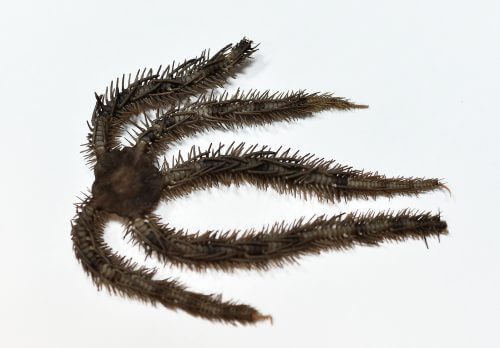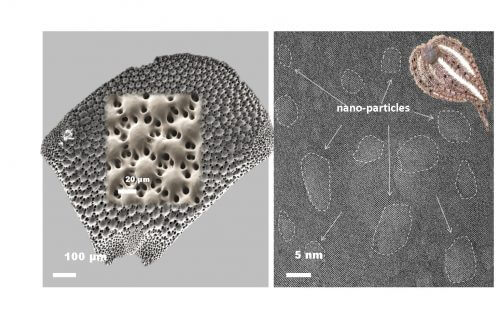An international research team led by researchers from the Technion deciphered the formation process of "blocked lenses" in an underwater environment

An international research group, led by Prof. Beaz Pokroy and researchers from the Technion's Faculty of Materials Science and Engineering, discovered how the sea urchin Ophiocoma wendtii produces materials similar to tempered glass, under the conditions that prevail underwater. The findings, published in the scientific journal Science, are expected to lead to the development of new ways to produce strong ceramic materials for a variety of uses.
The researchers revealed the unique defense mechanism of extremely durable lenses located on the arms of the Ophiocoma wendtii - a sea urchin that lives in underwater reefs. Hundreds of light-focusing lenses develop on the arms of this organism in a process that may aid in the development of durable ceramic materials. The lenses, made of chalk, are strong and precise, and deciphering their crystalline and nanometric structure has occupied Prof. Beaz Pokroy and his research group at the Technion for the past three years.
Prof. Pokroy studies materials created by living creatures and produces similar artificial materials using methods inspired by nature. Shells, pearls, bones and turtle shells are examples of biominerals - minerals created by the organism itself.
"What is impressive about bio-minerals is that they are made from the materials available to the organism - chalk, for example," says Prof. Pokroy. "Engineers would never choose chalk as a durable building material, but nature does, and successfully, by various strategies of strengthening and hardening. Moreover, these animals produce the bio-minerals under the conditions given in nature, without furnaces and pressing devices used in laboratories. Therefore, it is clear that we, as scientists and engineers, have a lot to learn from these processes."
In 2001, the journal Nature published an article by Prof. Joanna Eisenberg (who was later the supervisor of Prof. Pokroy in his post-doctorate at Harvard), in which was the first description of the sophisticated optical system of the sea urchin - Ophiocoma wendtii, made of microscopic lenses made of a substance called Calcite. These lenses focus the sunlight and project it onto nerve centers that transmit the information to the rest of the body through the nervous system.
"Ophiocoma wendtii lenses are produced in the open sea, not in a laboratory, and in fact we discovered a strategy to strengthen a brittle material and increase its resistance, under natural conditions," says Prof. Pokroy. "It is about 'crystal engineering' and blocking without heating and without pressing - a process that may be very effective in the science and engineering of materials."

For comparison, tempered glass and pressed concrete are produced by compression efforts - forces that compress the material and leave it in a more compressed state than its natural state. Glass blocking, for example, is performed by heating the material and rapidly cooling it. In this process, the outer part of the material cools faster than the inner part, thus compressing it.
The Technion researchers discovered that the crucial step in the production of the Ophiocoma wendtii lens is the transition from an amorphous phase - the phase between liquid and solid - to the crystalline phase. At this stage, nanoscale calcite particles rich in magnesium and characterized by a higher density at the atomic level are distinguished from the whole material. The difference between the magnesium concentrations in the different calcite particles creates different degrees of difficulty, density and pressure in different areas of the material. The magnesium-rich particles press on the inside of the lens during its crystallization process, thus "blocking" it into a transparent and very hard crystalline material.
"Nature shows great creativity in improving the abilities of the organism in various contexts such as strength, sensing and self-defense, and here we see great efficiency in the use that Ophiocoma wendtii makes of the available raw materials and produces, under the given conditions, very strong and precise lenses," says Prof. Pokroy.
Now scientists and engineers will be able to harness the strategy discovered in the research for the benefit of hardening and blocking artificial ceramic materials used in a variety of applications - from optical lenses to turbo engines and biomedical implants.
The formation process of the calcite lenses is deciphered in a long series of experiments in various facilities, including the particle accelerator in Grenoble (France) and the "Titan" microscope at the Technion. The mechanical analysis (analytical and experimental) was carried out by Prof. Nicola Fogno from the University of Trento in Italy, Queen Mary University of London and the Eduardo Ameldi Foundation at the Italian Space Agency. Prof. Pokroy and 9 other researchers from the Technion are partners in the article: Dr. Irina Polishchuk, Abigail Bracha, Yael Ettinger-Geller, Stas Kozchevich, Dr. Alex Katzman, Dr. Yaron Kaufman, Dr. David Levy and Unid Bloch. The partners abroad are Prof. Poppa Gilbert from the University of Wisconsin-Madison, Dr. Gordon Keller from the Los Angeles County Museum of Nature, Prof. Nicola Pogno, Dr. Paul Zaslansky from the Scharité Hospital in Berlin and scientists from the particle accelerator in Grenoble. The research was conducted with the support of the Russell Berry Institute for Research in Nanotechnology at the Technion, the Alon Fellowship and the European Research Council.
